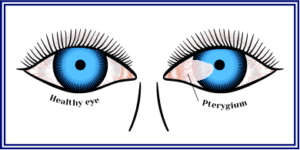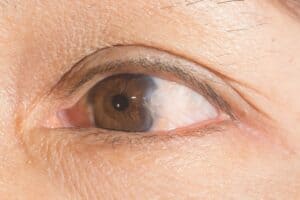Also serving patients in Fort Lauderdale
 A pterygium is a tissue growth on the cornea. This condition is more common in sunny climates and in the 20-40 age group. The causes of pterygium to develop are not known. However, since people who have pterygium usually have spent a significant time outdoors, many doctors believe ultraviolet (UV) light from the sun may be a factor, wind and dust as well as genetic predisposition.
A pterygium is a tissue growth on the cornea. This condition is more common in sunny climates and in the 20-40 age group. The causes of pterygium to develop are not known. However, since people who have pterygium usually have spent a significant time outdoors, many doctors believe ultraviolet (UV) light from the sun may be a factor, wind and dust as well as genetic predisposition.
Because a pterygium is visible, many people to have it removed for cosmetic reasons. However, your eye doctor may recommend to remove a pterygium when it is invading the cornea or when the discomfort and redness is not relieved by eye drops.
Pterygium surgery is ambulatory with topical anesthetic eye drops. The growth is excised completely. The chance of reoccurrence is greatly diminished due to a special chemical used during the procedure. Most patients go back to their normal activities as soon as two days after surgery. The use of eye drops may be necessary for approximately one month after this procedure.
In addition to providing highly effective pterygium treatment, the experienced surgeons at the Laser Eye Center of Miami specialize in glaucoma surgery, treatment for cataracts, and refractive laser procedures. In fact, the Laser Eye Center’s surgeons are among the most accomplished LASIK eye surgery specialists in Miami and Fort Lauderdale.
Pterygium FAQs
What are the Risk Factors for Pterygium?
 The most significant risk factor for pterygium is excessive UV exposure. This growth is ten times more common in locations near the equator because of higher UV rays, making Florida residents more prone to pterygium. You may be more likely to develop this wedge-shaped growth if:
The most significant risk factor for pterygium is excessive UV exposure. This growth is ten times more common in locations near the equator because of higher UV rays, making Florida residents more prone to pterygium. You may be more likely to develop this wedge-shaped growth if:
- You have a family history of pterygium.
- You live in a tropical or subtropical climate.
- You spend lots of time outdoors.
- You are regularly exposed to wind, dust and other environmental irritants.
- You are a smoker.
- You have a dark skin complexion.
- You are between the ages of 20 and 40.
- You are male. (Men are twice as likely to develop pterygium.)
What are the Symptoms of Pterygium?
Pterygium typically forms on the side of your eye nearest your nose but may develop on the other side and occur in one or both eyes. You may experience multiple growths at a time. The condition progresses slowly for some patients and suddenly for others. The formation of a pinguecula — a yellowish or white bump that grows near the cornea and is made of calcium, fat or protein — may be a precursor to pterygium. The following symptoms may occur with pterygium:
- Feeling like there is something in your eye, causing you to rub and wash your eyes
- A flesh-like growth appears at the corner of the eye and grows into a wing-shape or triangular mass
- Itching or burning eyes from poor lubrication caused by the growth
- Gritty, dry eyes that are worsened by environmental irritants
- Vision changes such as double or blurred vision if the growth extends over the pupil and alters the corneal shape
- Worsening astigmatism, nearsightedness or farsightedness
How is Pterygium Managed and Treated?
Irritating symptoms of pterygium may be managed with lubricating eye drops or artificial tears that moisten the growth and relieve burning or itching eyes. Corticoid steroid eye drops can reduce inflammation and irritation caused by pterygium. Surgeryremoves the growth completely, and the use of Amniotic membrane significantly lower the risk of reoccurring pterygium.
Can Pterygium be Prevented?
 Yes, pterygium may be prevented through protective measures when you are in the sun and exposed to UV rays. Wearing sunglasses that block 99 percent of UVA and UVB light rays can lower your chances of developing the eye growth. Even in overcast weather, you should protect your eyes as UV light passes through the clouds. Wraparound sunglasses are best and protect you from wind, sand and dust in the air. A wide-brimmed hat can protect you from UV rays if you cannot wear sunglasses.
Yes, pterygium may be prevented through protective measures when you are in the sun and exposed to UV rays. Wearing sunglasses that block 99 percent of UVA and UVB light rays can lower your chances of developing the eye growth. Even in overcast weather, you should protect your eyes as UV light passes through the clouds. Wraparound sunglasses are best and protect you from wind, sand and dust in the air. A wide-brimmed hat can protect you from UV rays if you cannot wear sunglasses.
Is Pterygium Cancerous?
No, pterygium is often a benign, harmless eye growth. In rare cases, a pterygium may harbor cancerous cells, which is why you should schedule an eye exam to investigate any changes in your vision or eye health at Laser Eye Center of Miami.
What Is the Difference Between Pterygium and Pinguecula?
Pterygium and pinguecula are both growths that develop on the conjunctiva, the thin membrane covering the white of your eye. However, they are not the same. A pinguecula is a yellowish, raised bump near the cornea, usually caused by sun exposure. It does not grow over the cornea. A pterygium, on the other hand, is a fleshy, wedge-shaped growth that can extend onto the cornea and affect vision. While both conditions result from UV exposure and environmental factors, pterygium is more likely to require medical intervention.
Can Pterygium Affect Both Eyes?
Yes, pterygium can develop in both eyes, a condition known as bilateral pterygium. It is not uncommon for people who spend a lot of time outdoors to experience growths in both eyes simultaneously. The severity and progression can vary from one eye to the other. If you notice signs of pterygium in either or both eyes, it’s important to seek evaluation from an eye specialist.
How Long Does Pterygium Surgery Take, and What Is the Recovery Time?
Pterygium surgery is a relatively quick outpatient procedure, typically lasting between 30 to 45 minutes. The recovery time varies by individual, but most patients experience initial healing within a few weeks. Full recovery can take several months as the eye completely stabilizes. Your eye doctor will provide post-surgery care instructions, including the use of medicated eye drops to prevent inflammation and infection.
Are There Any Non-Surgical Treatments for Pterygium?
If pterygium is mild and not affecting your vision, non-surgical treatments may help manage symptoms. Lubricating eye drops, anti-inflammatory medications, and wearing UV-blocking sunglasses can reduce irritation and slow progression. However, if the growth begins to interfere with vision or becomes persistently inflamed, surgery is often recommended.
What Happens If Pterygium Is Left Untreated?
In some cases, a pterygium remains small and does not cause significant problems. However, if left untreated, it can continue to grow and cause vision impairment by altering the shape of the cornea (inducing astigmatism) or covering the pupil. It may also lead to chronic irritation and discomfort. Early evaluation and management are essential to prevent complications.
Can Pterygium Come Back After Surgery?
Yes, pterygium can recur after surgery, but recurrence rates are significantly lower with advanced surgical techniques. Using conjunctival autografting, where healthy tissue is placed over the affected area, has been shown to reduce recurrence. Patients can also minimize the risk of regrowth by avoiding excessive sun exposure and wearing protective eyewear.
What Type of Anesthesia Is Used for Pterygium Surgery?
Pterygium surgery is typically performed under local anesthesia with mild sedation to keep you comfortable. You will be awake but will not feel pain during the procedure. The use of local anesthesia allows for a quicker recovery and reduces the risks associated with general anesthesia.
Are There Any Risks or Complications Associated with Pterygium Surgery?
As with any surgical procedure, there are potential risks, although they are rare. Some possible complications include infection, inflammation, scarring, or recurrence of the pterygium. Your eye surgeon will take necessary precautions to minimize risks and ensure the best possible outcome. Following post-operative care instructions is essential for a smooth recovery.
What Is the Next Step?
If you’re experiencing discomfort, vision disturbances, or a visible growth on your eye, it’s time to seek expert care. At the Laser Eye Center of Miami, our specialists provide advanced treatment options to help restore your eye health. Contact us today to schedule a consultation and take the first step toward clear, comfortable vision.
Contact Laser Eye Center of Miami About Pterygium
If you have a pterygium or it’s time for your next eye exam, contact our skilled eye doctors and surgeons at the Laser Center of Miami today to schedule your appointment in Miami or Fort Lauderdale.






